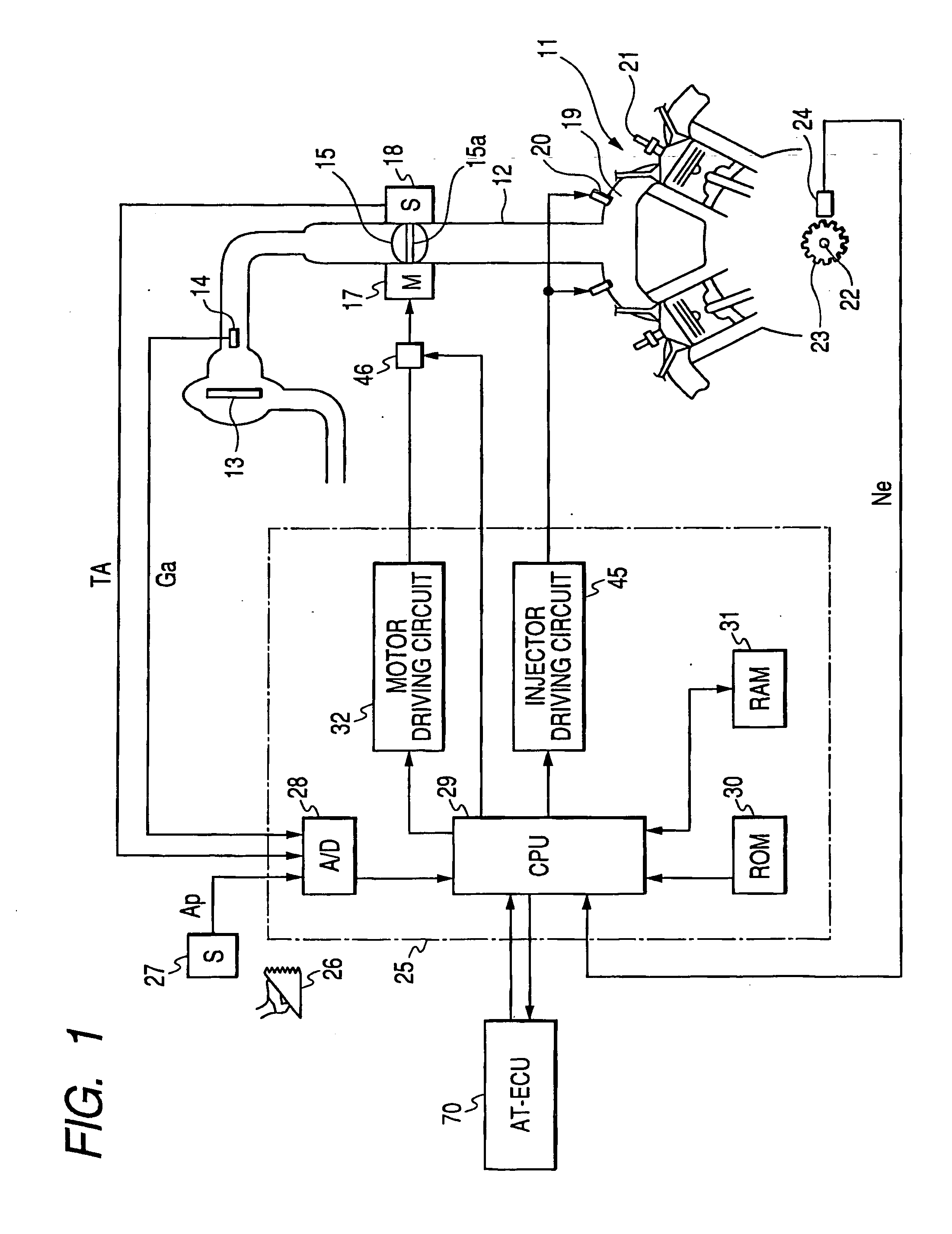Control apparatus for an automatic transmission and related control method
a control apparatus and automatic transmission technology, applied in the direction of electric control, machines/engines, transportation and packaging, etc., can solve the problems of increasing the engine brake force, and reducing the control effect of the automatic transmission. , to achieve the effect of suppressing undesirable acceleration or shock, increasing control, and simple logical arrangemen
- Summary
- Abstract
- Description
- Claims
- Application Information
AI Technical Summary
Benefits of technology
Problems solved by technology
Method used
Image
Examples
first embodiment
[0061] A first embodiment of the present invention will be explained with reference to FIGS. 1 to 22. FIG. 1 schematically shows an overall arrangement of a control system for an internal combustion engine 11. The engine 11 has an intake pipe 12, an air cleaner 13 disposed at an upstream portion of the intake pipe 12, and an air flow meter 14 disposed at a downstream side of the air cleaner 13 to measure an intake air amount Ga. Furthermore, a throttle valve 15 is provided at a downstream side of the air flow meter 14. A motor 17, such as a DC motor, is connected to a rotational shaft 15a of the throttle valve 15. The motor 17 generates a driving force for controlling an opening degree of the throttle valve 15 (i.e. throttle opening degree). A throttle opening degree sensor 18 detects the throttle opening degree.
[0062] The intake air, after having passed the throttle valve 15, flows into an intake manifold 19 that introduces the intake air into each cylinder of the engine 11. A pre...
second embodiment
[0152]FIGS. 23 and 24 show a second embodiment of the present invention that is made based on the fact a gear ratio (=input shaft rotational speed Nt / output shaft rotational speed No) decreases when the input shaft rotational speed Nt decreases after the ETC cooperative downshift control starts. At the timing the gear ratio falls below a set value after the ETC cooperative downshift control is started, it is presumed that the hydraulic pressure of the to-be-disengaged clutch is already reduced to a hydraulic pressure level equivalent to a predetermined transmission torque capacity that causes no undesirable acceleration or shock even if the engine output increasing control is started. And, under such assumption, the engine output increasing control is started at this timing.
[0153]FIG. 24 shows a throttle opening control start judging routine according to the second embodiment of the present invention. When this routine starts, a judgment is made in step 223 as to judge whether or n...
third embodiment
[0155] In some cases, as shown in FIG. 25, the input shaft rotational speed Nt or the gear ratio may not decrease sufficiently depending on engine control conditions even after the ETC cooperative downshift control is started; In such a case, according to the above-described first and second embodiments, the engine output increasing control will not start for a relatively long time.
[0156] Hence, according to a third embodiment of the present invention shown in FIGS. 25 and 26, an elapsed time timer (i.e. timer means) is provided to measure the time having elapsed after the ETC cooperative downshift control is started. When the engine output increasing control does not start even after the elapsed time exceeds the set value, the engine output increasing control is forcibly started.
[0157]FIG. 26 shows a throttle opening control start judging routine according to the third embodiment of the present invention. When this routine starts, a judgment is made in step 223 as to whether or n...
PUM
 Login to View More
Login to View More Abstract
Description
Claims
Application Information
 Login to View More
Login to View More - R&D
- Intellectual Property
- Life Sciences
- Materials
- Tech Scout
- Unparalleled Data Quality
- Higher Quality Content
- 60% Fewer Hallucinations
Browse by: Latest US Patents, China's latest patents, Technical Efficacy Thesaurus, Application Domain, Technology Topic, Popular Technical Reports.
© 2025 PatSnap. All rights reserved.Legal|Privacy policy|Modern Slavery Act Transparency Statement|Sitemap|About US| Contact US: help@patsnap.com



